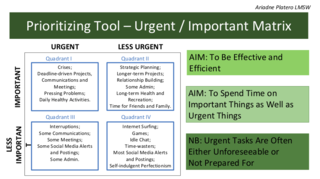Motivation
Turn Plans and Goals Into Action with Clear Prioritization
Using the Important/Urgent Matrix to prioritize and organize goals.
Posted August 11, 2021 Reviewed by Chloe Williams
Key points
- Once goals have been set, turning them into action and figuring out which goals to prioritize above others can be a difficult process.
- The Important/Urgent Matrix splits goals into four quadrants—important and less important, or urgent and less urgent—and can help set priorities.
- Tips for creating the matrix include limiting the number of items in each quadrant and pulling from personal as well as professional goals.
In my last post, we looked at setting goals, using a goal timeline or SMART goals, and the benefits of some basic activities such as creating time for insight and reflection, and making sure to write down the results. All of this is important. However, I’m as aware as anyone that this does not automatically move us to achieve these goals.
So, once we’ve defined and set our goals, sorted them out into short, medium, and long-term categories, checking the compatibility of goals in different time periods, how do we turn these goals and plans into action?
Many clients describe getting stuck at this point, regardless that they know the importance of getting started and however passionate they are about the outcome. Worse, still, for those who have tasks that need to be completed but don’t possess a clear enthusiasm for either the tasks or the outcomes, as maybe they are just means to an end. This is often because too many demands compete for their attention. As a result, there is a pressing need to prioritize goals in order to clear the way for those first steps and, ultimately, achievement.
I often use the analogy of a messy desk (maybe, I confess, because it’s an ongoing challenge to keep mine tidy) and the need, metaphorically and mentally, to clear off extraneous items in order to focus on one thing at a time to get things done. For some, the need is literally to clear your desk, depending on the state of your actual workspace as opposed to your mental goal-space.

When we are at the stage of discovering and setting goals, I encourage expansive thinking. Nothing is too much of a reach or too outlandish to be considered. In fact, it’s important to expand your thinking at this point so you don’t end up with goals that are overly influenced by others' expectations or accepted norms, but the action stage is no time for such a wide array of possibilities.
Developing Priorities with the Important/Urgent Matrix
One way to sort through and develop priorities is to use the Important/Urgent Matrix (see image). This matrix, more useful in daily life than its original, derives from the Eisenhower Matrix which, in turn, comes from the Eisenhower Principle: that there are two kinds of problems, the urgent and the important; the urgent are not important and the important are never urgent. While this may have been true for the Allied Forces Supreme Commander and US president, it is rarely true for the rest of us. In fact, the earlier Eisenhower matrices were broken down into: do, decide, delegate, and delete. This is pithy and alliterative, but it may be more useful if you’re already right at the top of an organizational tree. For the rest of us, the updated more useful graph breaks down into quadrants of: important and less important, or urgent and less urgent. Before you get concerned about the labeling of such absolutes, remember this is just a tool to help you move forward.

To fill out the matrix, it can be tempting to draw our priorities from our list of short-term goals as it seems obvious that we must do them earlier. While this is partially true, we must also draw from the medium and long-term goals selectively, as it is with these in mind, that we can carve out time for the planning and preparation which lay the foundations for longer-term goals. You will often see these items in the important but not urgent quadrant. Although this tool should be personalized depending on individual needs and circumstances, here are some guidelines for when you first create and use it.
Creating the Matrix
First, limit the number of items in each quadrant. There is no ideal number but you should experiment with what works for you and the kinds of tasks you are trying to complete. Try limiting to between four and eight items and see what works best for you.
Second, keep both work and personal goals on the same matrix. This way you won’t inadvertently ignore one for the other.
Third, be careful of outside distractions or the priorities of others, both in creating your matrix and once it’s in place. Without caution, they may prevent you from completing your selected top priority tasks in favor of completing theirs. Emergencies or issues of safety (yours or others) are an obvious exception.
Fourth, this matrix is not set in stone. Not only will it shift as tasks are completed, but also as new information is received and priorities change. Ideally, review it daily.
Fifth, mentally prepare for, even if you don’t actually schedule the time, unforeseen emergencies so that they don’t throw you for a loop when they occur.
Using the Matrix
First, set aside time in your day for the list in Quadrant I, important and urgent, but don’t let this dominate all your time. While this may not be possible every day — we’ve all known days when putting out fires and hitting immediate deadlines is all we have time for — this is, nevertheless, key. You must set aside time during your day and week for the items in Quadrant II, important but not urgent. This will advance your longer-term and larger goals, and make time for strategic planning and perspective-taking.
Second, items from Quadrant III are inevitable but, be your own policeman, control them, minimize them, notice if they’re taking over your time, and find a way to limit that.
Third, eliminate Quadrant IV as much as possible. If there are some which must be done, or you find them utterly irresistible, use them as a reward, schedule them in a very limited time slot, and set an alarm to remind you when it’s over.
Fourth, do not multitask. No ifs, ands, or buts. All the research evidence shows us that we work less efficiently when we do.




